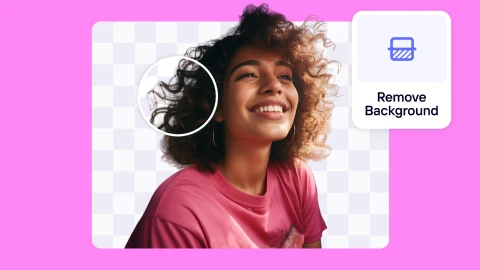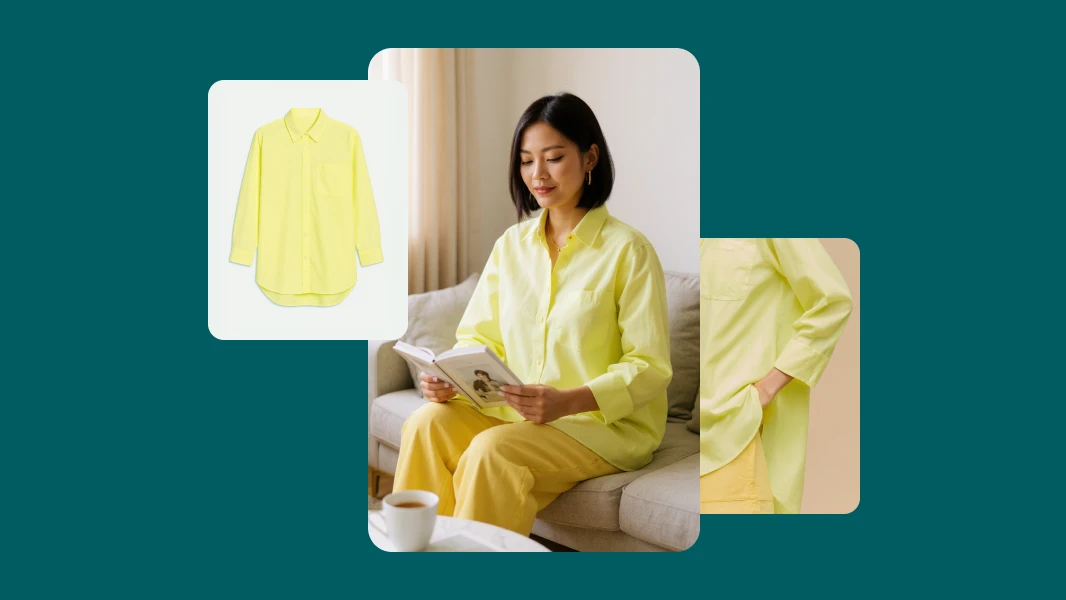Scaling product photos: manual vs automation explained
“Should we automate our product photography or hire more photo editors?” is the wrong question. The right one is: “Which parts of our workflow should we automate, and which still need human editing?”
While it’s tempting to treat manual editing and automation as either/or approaches, the most successful brands balance both. Manual editing is valuable for personalized creative editing; automation is the only way to scale product visuals consistently.
Photoroom, the AI-powered product photography platform built for commerce, helps businesses of any size balance manual editing with automation, providing large-scale automation through a robust API and hands-on creative control through an app with a graphical user interface (GUI).
Talk with our sales team about Photoroom's workflow for enterprises →
This article covers when manual editing works, why it can't scale, when automation wins, how to choose GUI vs API, and how to implement hybrid workflows that grow with your business.
Manual vs automation at a glance
Here’s a quick comparison of manual and automated workflows.
| Factor | Manual editing | Automated editing |
|---|---|---|
| Best for | Personalized campaigns, complex creative projects | Large catalogs, marketplace listings, multi-channel distribution |
| Cost per image | $10-$25 | $0.02-$5 |
| Scalability | 50-100 images per editor per day | 5,000+ images processed in hours |
| Consistency | Varies across editors, agencies, and time periods | Standardized across all images |
| Turnaround | Days to weeks depending on queue | Minutes to hours with batch processing |
| Multi-channel output | Manual recreation for each format | Automatic variants from source image |
When does manual editing make sense?
Manual editing produces better results in specific scenarios where human judgment, creative direction, or specialized expertise matter:
Personalized campaign assets that define brand positioning and require conceptual thinking.
Luxury products like high-end jewelry and artisanal goods, where pixel-level detail on texture and material communicates craftsmanship.
Complex materials like reflective surfaces, translucent items (cosmetics, liquids), and intricate textures (embroidery, circuit boards). These need a depth of nuance that most current automation systems can’t handle.
Specialized retouching for apparel on models or electronic items. These tasks require judgment calls about what's acceptable enhancement versus misleading alteration.
Editorial content where products are integrated into lifestyle scenes, or you need to consider context, narrative, and visual storytelling when compiling user-generated content.
Small batches for limited releases or test products (under 100 images), where the time for setting up automation often exceeds the time saved.
Photoroom complements these high-touch creative tasks by automating the repetitive parts of image production, freeing teams to focus on the visual storytelling that still needs human direction.
Why can’t manual editing scale?
Manual editing limits growth for e-commerce and marketplace teams. Here’s why it fails to scale efficiently.
1. Consistency varies across editors
When multiple people edit similar products, it causes variations in color correction, cropping, shadow intensity, and image backgrounds. These variations confuse customers and weaken brand recognition.
2. Talent gets misallocated
Designers spending 70% of their time on background removal and format standardization can’t allocate more time to strategic work that drives revenue. Over time, this imbalance affects brand creative positioning and growth.
3. Scale hits a ceiling
A skilled editor might edit 50-100 product images daily, depending on complexity. But if a seasonal launch requires 5,000 images, the same editor would spend 50–100 full workdays editing, which can delay launch or reduce output quality due to rush work.
4. Costs don’t improve
Agency and freelancer fees stay constant or increase over time. Your brand can pay $10-$25 per image or up to $5,000 per image for editing, which increases as volume grows. The per-unit economics don't improve with scale, and that fixed cost structure makes rapid growth financially unsustainable.
Manual editing enables specialized expertise for premium creative assets. But it can't scale to enterprise catalog volumes or multi-market timelines. That’s where automation changes everything, solving the scaling challenges that manual workflows can’t.
Photoroom solves manual editing bottlenecks as an all-in-one AI product photography platform built for commerce, helping businesses of any scale maintain speed and consistency as they grow.
Why is automation the only way to scale product photography?
Automation reduces both cost and turnaround time by over 90% compared to manual editing. Say you're processing 50,000 product images a year:
| Manual editing | Automated processing | Savings with automation | |
|---|---|---|---|
| Cost per image | $10–$25 | $0.02–$5 | $9.98–$20 |
| Annual cost | $500,000—$1,250,000 | $1,000—$250,000 | $499,000—$1,000,000 |
| Throughput | 50–100 images/day | 5,000+ images in hours | 50–100× faster with automation |
See how much time and cost you could save with automation — calculate your ROI here →
Manual editing is inefficient after 200 SKUs. You can push through at 500 SKUs, but as your catalog grows across multiple markets and channels, manual workflows delay launch dates and increase expenses.
Beyond cost and time efficiency, here are the benefits of automating image editing:
Reduce time-to-market with batch editing: Process thousands of images at once and cut listing time from days to seconds. Businesses automating with Photoroom, including Goodwill and Selency, report faster launches and smoother seasonal rollouts with Photoroom's AI product photography features.
Increase conversions with consistent visuals: Automation ensures every image aligns with brand guidelines across channels and markets. This consistency builds customer trust and can increase CTR by 73%, and deliver up to 23% higher conversion rate for businesses.
Drive measurable revenue growth: Faster product listings mean earlier sales, higher average order values, and up to 100% increase in sales for Photoroom enterprise partners.
E-commerce product photography automation is a business strategy, but only with software that delivers speed, consistency, and scale. This is why 42% of businesses adopt AI workflows for marketing tasks such as visual preparation. Photoroom is the best partner for e-commerce teams to scale brand visuals with AI tools for product photo editing.

How to combine manual and automated image editing workflows
The most efficient product photo workflows combine automation and manual editing. A practical benchmark for enterprise teams is an 80/20 split: automate around 80% of your image workflows, and keep the remaining 20% for manual attention.
The exact breakdown varies based on your business model, brand positioning, and image volume. But the principle remains the same: automation handles volume, and manual handles specialization.
Automate 80% of your workflow for:
Standard catalog photography, where products need a consistent presentation.
Marketplace listings following platform guidelines.
Multi-channel distribution requiring format variants.
Seasonal refreshes when updating thousands of existing images.
Any scenario where speed, consistency, and scale outweigh the need for creative interpretation.
Keep the remaining 20% manual for:
Campaign assets that set seasonal visual direction.
Luxury products where detailed work impacts perceived value.
Brand storytelling assets in editorial or lifestyle contexts.
Products that require specialized retouching, like apparel on models or food styling.
Creative projects where aesthetic judgment drives differentiation.
When you merge both editing models, you create a system where automation handles catalog production, freeing up your creative team to focus on work that differentiates your brand—developing campaigns, evolving visual identity, and solving creative problems that drive competitive advantage.
Photoroom supports hybrid image editing workflows with both a GUI for hands-on creative control and an API for scaling image processing.
How to automate product photo editing: GUI vs API explained
There are two main ways to automate product photo editing: through a visual interface (GUI) or by connecting systems directly (API). Photoroom supports both, giving your brand the flexibility to start simple and scale through full automation. Here's how to think about which fits your workflow.
What is a GUI (graphical user interface)?
A GUI is the visual interface you see and interact with when using software. In photo-editing platforms, that means clicking buttons or menus to upload images, adjust edits, and download processed files without writing code. It's like using traditional editing software, but with automation built into modern platforms.
What is an API (application programming interface)?
An API is how software tools talk to each other automatically. Instead of using a visual interface, an API connects your systems behind the scenes, automating workflows with minimal to zero manual intervention. For example: you upload photos to your digital asset management (DAM), and the API triggers editing based on predefined rules before sending finished images directly to your e-commerce platform, removing manual handoffs entirely.
Should you use a GUI or an API for product photo editing?
Choosing between a GUI and an API depends on your image volume, team capacity, and desired automation level. Small teams that want hands-on editing use GUI systems. Enterprises adopt API-driven workflows to automate product photography at scale.
Use the table below to compare GUI and API approaches side by side to see which is better for your product photo workflow.
| Factor | Choose GUI | Choose API |
|---|---|---|
| Volume | Hundreds to a few thousand images/month | Tens of thousands of images/month |
| Team structure | Small teams of creatives, designers, marketing ops | Technical teams, developers, enterprise IT |
| Workflow needs | Hands-on control, creative review before publishing | Automated pipelines, minimal human intervention |
| Technical resources | No developers available | Technical team can build integrations |
| Use case | Batch processing with oversight | System-level automation at scale |
| Integration priority | Standalone tool or light integration | Deep integration with DAM/PIM/e-commerce |
Photoroom is the only platform that combines hands-on creative control with enterprise-level automation, giving brands true flexibility as they scale. The key is choosing a platform that supports both GUI and API approaches. You don't want to migrate platforms and transfer data just because your volume increases.
Photoroom provides both the visual interface teams need for creative control and the API-driven workflows to automate product photo editing at scale on the same platform.
How Photoroom scales product photography for enterprise brands
Photoroom is the all-in-one AI product photography solution built for commerce, giving enterprise brands hands-on AI tools for product photo editing and automation at scale. Once integrated, Photoroom simplifies every stage of product photography, from bulk editing to system-level automation.
Here’s how enterprise teams use Photoroom to scale image production efficiently:
Process thousands of images: Photoroom batch edits 1,000+ product shots in minutes. Upload your catalog, and it applies consistent backgrounds, sizing, and enhancements across all images.
Run smooth integrations: Your technical team gets dedicated support during setup to help you easily connect the Photoroom API to your DAM, PIM, and e-commerce platforms.
Start simple, scale when needed: Use the web app for batch editing product images and team collaboration when you're getting started. As volume grows, your technical team can plug the API into your existing systems without rebuilding workflows.
French circular marketplace Label Emmaüs started with the Photoroom app to test what worked before rolling out the API to automate image processing for their sellers. The brand gained better visuals and up to a 56% increase in conversion rate.
Other brands report similar results: 75% less time editing, 93% cut in editing cost, and average order values up 236%. Photoroom handles product photography at enterprise scale, letting creative teams batch-edit in the web app while technical teams automate catalog workflows through the API.
Try the web app and API playground to see how Photoroom automates your current image workflow in real time.
Scale product photo workflows strategically
E-commerce brands that combine creative manual editing and automated workflows launch products 4x faster while maintaining a stronger brand identity across channels.
Photoroom helps brands scale product photos with both the GUI for hands-on editing and the API for processing large catalogs. This combination creates visual experiences that engage customers and drive sales for your business.




Design your next great image
Whether you're selling, promoting, or posting, bring your idea to life with a design that stands out.
















